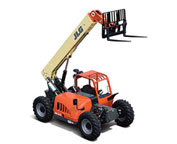
Forklift Brakes - A brake drum is in which the friction is provided by the brake pads or brake shoes. The pads or shoes press up against the rotating brake drum. There are some various brake drums kinds with certain specific differences. A "break drum" would usually refer to if either shoes or pads press onto the inner outside of the drum. A "clasp brake" is the term utilized so as to describe when shoes press next to the outside of the drum. Another kind of brake, called a "band brake" uses a flexible belt or band to wrap all-around the outside of the drum. If the drum is pinched in between two shoes, it could be known as a "pinch brake drum." Similar to a typical disc brake, these kinds of brakes are somewhat rare.
Early brake drums, before 1955, needed to be consistently modified so as to compensate for wear of the shoe and drum. "Low pedal" could result if the needed modifications are not done sufficiently. The vehicle could become hazardous and the brakes could become useless when low pedal is combined along with brake fade.
There are different Self Adjusting Brake Systems accessible, and they can be categorized within two main kinds, RAD and RAI. RAI systems have built in devices which prevent the systems to be able to recover whenever the brake is overheating. The most well known RAI makers are AP, Bendix, Lucas, and Bosch. The most famous RAD systems comprise Volkswagen, VAG, AP, Bendix and Ford recovery systems.
The self adjusting brake will normally only engage whenever the forklift is reversing into a stop. This method of stopping is suitable for use whereby all wheels utilize brake drums. Disc brakes are used on the front wheels of vehicles these days. By functioning only in reverse it is less possible that the brakes would be adjusted while hot and the brake drums are expanded. If tweaked while hot, "dragging brakes" can take place, which increases fuel expenditure and accelerates wear. A ratchet device which becomes engaged as the hand brake is set is another way the self adjusting brakes could operate. This means is just appropriate in applications where rear brake drums are used. If the parking or emergency brake actuator lever exceeds a specific amount of travel, the ratchet advances an adjuster screw and the brake shoes move in the direction of the drum.
There is a manual adjustment knob placed at the bottom of the drum. It is typically adjusted through a hole on the opposite side of the wheel and this involves getting beneath the forklift along with a flathead screwdriver. It is of utmost significance to be able to move the click wheel properly and tweak every wheel evenly. If uneven adjustment takes place, the vehicle could pull to one side during heavy braking. The most efficient method so as to make certain this tiresome task is accomplished carefully is to either lift each wheel off the ground and hand spin it while measuring how much force it takes and feeling if the shoes are dragging, or give everyeach and every one the exact amount of manual clicks and then do a road test.
![]() Click to Download the pdf
Click to Download the pdf
Forklift Parts








Lift Parts Express
TOLL FREE: 1-888-695-7994
LOCAL: (623) 900-4309
4980 S Alma School Rd A2-247
Chandler, Arizona
forkliftpartschandler.com
Email Us
About Us



